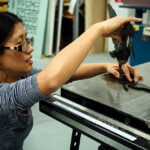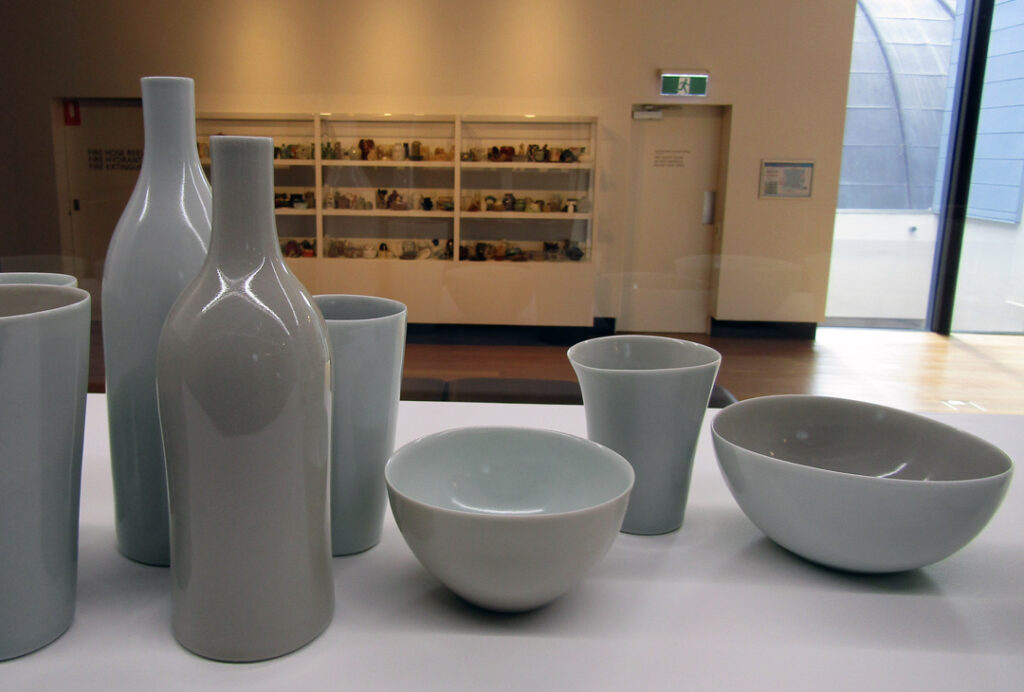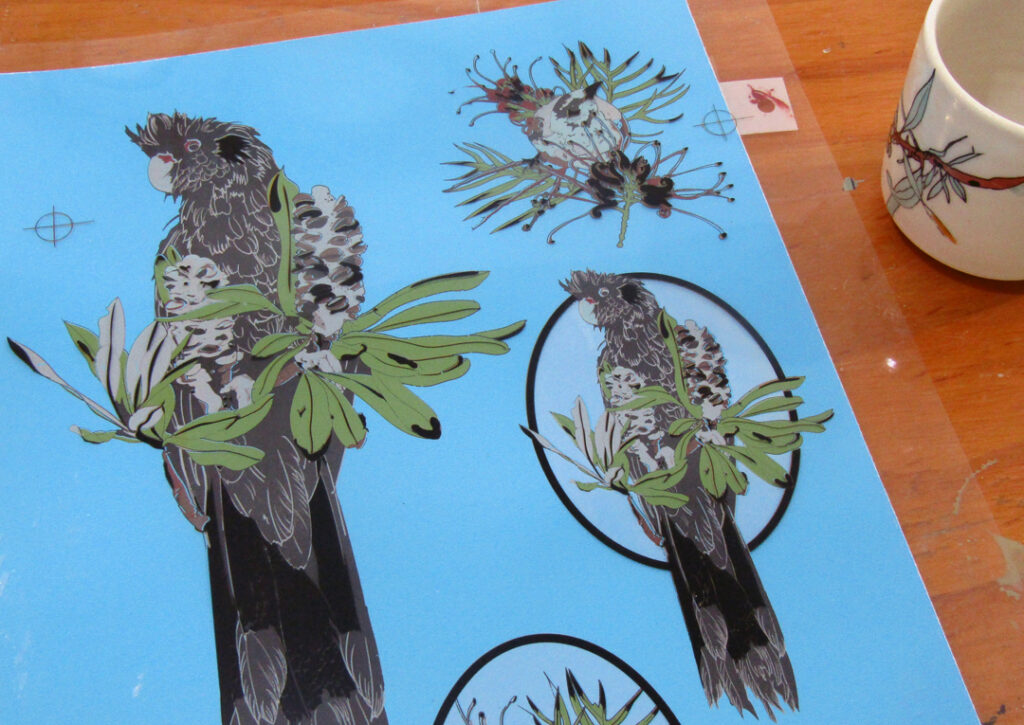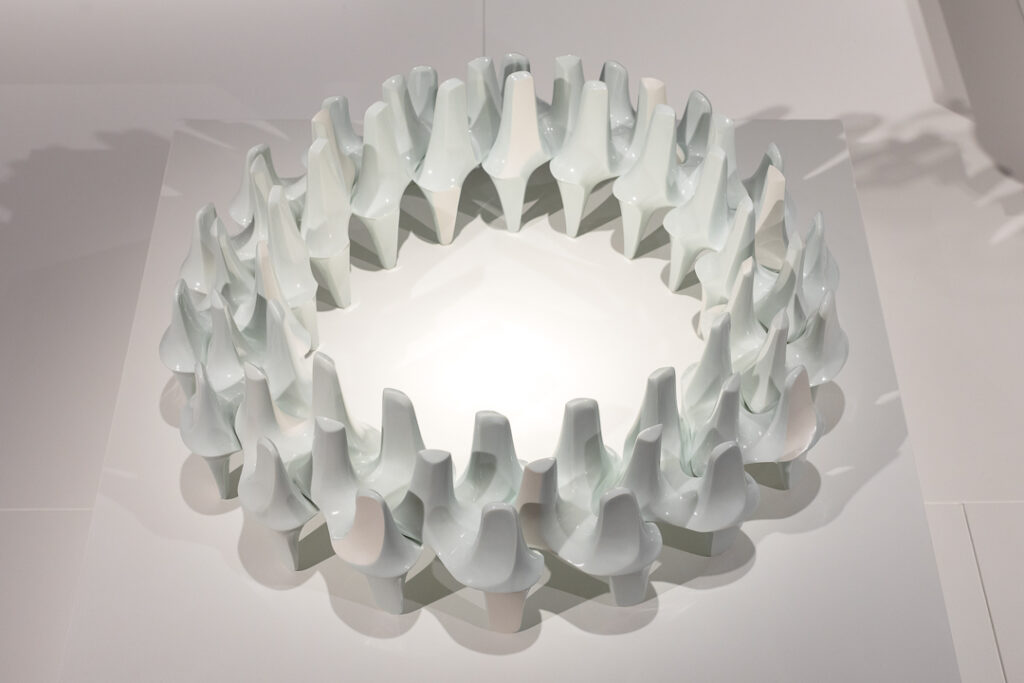
Kenji’s artwork, from Clay: Collected Ceramics, courtesy of Museum of Brisbane and photographed by Katie Bennett
Pamela See reviews a ceramics exhibition that reveals a vibrant Brisbane scene using clay as a language of fragility.
Between 10 – 28 May 2023, Brisbane Art and Design (BAD) Festival provided an absorbing snapshot of the diverse communities of practice within South-East Queensland (SEQ). Clay was the theme for this fourth iteration of the annual celebration. Its fulcrum was a pair of exhibitions, Clay: Collected Ceramics and Commune, which are open at Museum of Brisbane (MoB) until 22 October. Whereas the former is a curated core of some of the finest ceramics in the MoB collection, including numerous recent acquisitions, the latter is a showcase of over 300 respondents to its “largest community callout to date”.
This fervour in engagement extended beyond the makers, with a myriad of organisations across the municipality holding events using clay. Although “explosion” may be a term that inspires trepidation amongst potters, it is a manner of describing the influx in interest. The significance of this medium was also reflected by an acquiescence from non-enthusiasts in the sector. Clay has played an integral role in instigating the written history of many civilizations. Whereas the Sumerians (c. 4100-1750 BCE) created accounting records in cuneiform on clay tablets, the Yangshao (c. 5000 – 3000 BCE) inscribed ceramic burial urns to distinguish between their deceased. What might the vessels currently on display capture of their time?
In an adjacent exhibition and presenting a segue across three gallery spaces within MoB, is a ceramic grouping made by the matriarch of Queensland ceramics: the late Gwyn Hanssen Pigott. The Ballarat-born artist set up her final pottery in Ipswich at the turn of the twenty-first century. After completing a bachelor’s degree in fine arts at the University of Melbourne, she honed her skills in fashioning functional tableware through an apprenticeship with Ivan McMeekin in New South Wales. She sought further mentorship from ceramicists in the United Kingdom, including the author of A Potter Book, Bernard Leach, and a key figure in the “studio pottery” movement, Michael Cardew. She may have developed skills in “fast wheel–throwing” in England. The nascence of her ethereally fine Limoges porcelain vessels might be found in France. She ran her own pottery in Acheres between the mid-1960s and early 1970s.
In 1971, she saw a retrospective of Giorgio Morandi at the Musée National d’art Moderne in Paris. This experience inspired the recipient of an Order of Australia to create charismatic groupings of vessels. Still Life (Four Bottles) (1987), was one of her first groups. One of her last, Trail with Purple Beakers (2012), was made in the year before her passing. During this period, she slip-cast components of some groups from wheel-thrown originals. Amongst her artworks in Clay: Collected Ceramics is Still life with Green Bowl (1994). Although technically curated into The Locals, the luminous Breath (2000) presides over the “commune” in the adjacent space. Pigott’s journey characterizes artistic pursuits from Late Victorian to Modernist Australia, when practitioners of means acquired their skills through sojourning in Europe.
A more recent era of Australian creative practice is represented by the inclusion of Japanese-born, Brisbane-based ceramicist Kenji Uranishi. A graduate of the Nara College of Fine Arts, the consummate craftsman had exhibited in museums across his homeland prior to his migration in 2004. He hand-builds abstract forms from finely rolled slabs of porcelain clay that can appear breathtakingly fragile. Although inspired by geometries that occur in nature, many of his sculptures have an architectural aesthetic. This has been exploited as monumental public art on Kingsford Smith Drive in Brisbane. His contribution to Clay: Collected Ceramics is amongst the artworks especially commissioned for the exhibition. The enigmatic Between Two Worlds (2023) was inspired by the “inky” shadows cast by mangrove roots in moonlight. The artist has embraced the resilience of this species as a metaphor for his migrant experience.
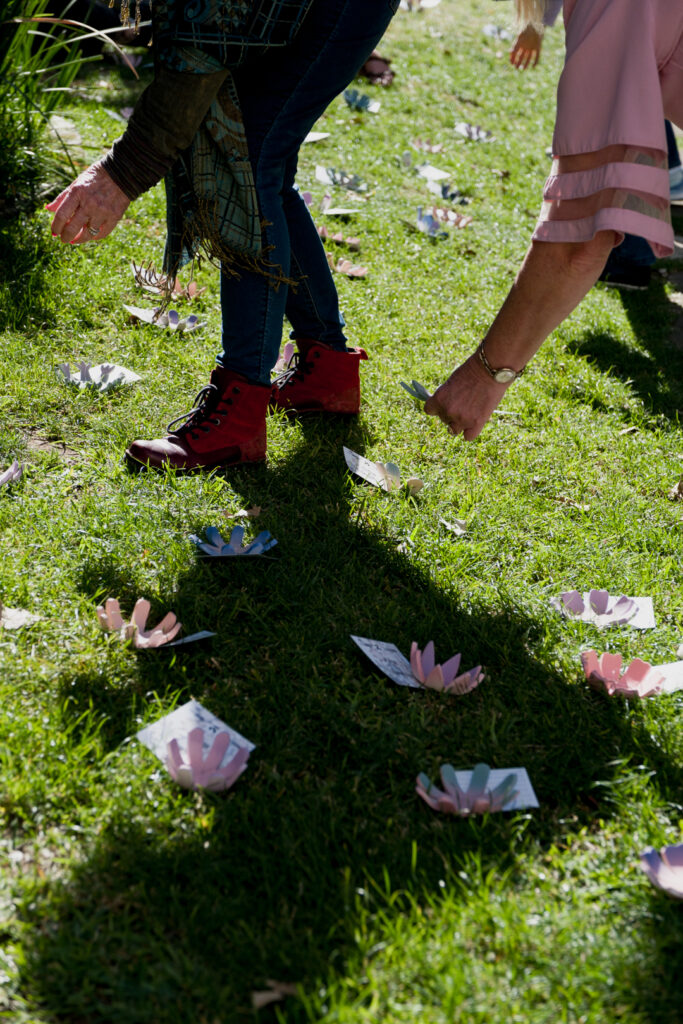
Minqi Gu and Brian Robinson collaborated on the temporary public artwork Harvest at West Village on 27 May. Photograph by Charlie Hillhouse.
Minqi Gu is one of the contributors to Commune. She immigrated from China at the age of ten, and has a Master of Architecture from the University of Sydney. Whilst transferring some principles from this discipline into her craft practice, she is drawn to the relative autonomy afforded to her as a ceramicist. Her slip-cast vessel, Cloud (2023), combines the conciseness of a cube with the playfulness of bubbles, or at least the impression they might have left against a form. A gentle gradation of blue and black was airbrushed using ceramic “stain” or pigment after the bisque firing. She applied a similar approach to colouring the white earthenware in Harvest, one of the temporary public art installations associated with BAD. Hosted by Metro Arts, Gu collaborated with Brian Robinson to embellish West Village with a set of florals on 27 May.
- Simon Suckling’s vessel features a noisy minor and grevillea in Commune.
- Simon Suckling painstakingly had prints up to eight silk-screens of digitally drawn illustrations onto his vessels
Amongst the exhibitors in MoB who staged open studios on 21-23 May was Simon Suckling, the proprietor of Blue House Porcelain. Born in the United Kingdom, he immigrated with his art teacher mother and scientist father. They settled in Gatton, where his father taught at the Queensland Agricultural College, which amalgamated with the University of Queensland in 1989. He undertook training in visual arts and ceramic design at the University of Southern Queensland and Monash University respectively. His postgraduate studies coincided with his working in a commercial pottery in Melbourne, producing porcelain tableware. His vessel in Commune is adorned by a noisy minor and a grevillea flower. It is part of a series investigating how “the natural world collides with built forms” and “plants and animals compete for survival” in inner-city Brisbane. The graphics in this series were painstakingly transferred using up to eight silk screens. The substrates were wheel-thrown and fired twice. The process was completed with a third firing to infuse and glaze the surfaces. Notably, his elegant illustrations were hand drawn with “digital design hardware and software”.

Melina Anouche’s sculptures in her solo exhibition at KEPK appear to defy gravity from Clay: Collected Ceramics.
One of the most intriguing of the satellite events featuring clay was Anoosh de Broc. Between 12 – 16 May, KEPK hosted this inaugural solo exhibition by Melina Anouche, who runs an atelier in the precinct. French-born, she immigrated in 2015 to pursue a Doctor of Philosophy (PhD) at the Queensland University of Technology (QUT) in the biological sciences. Her research involves scanning and analysing the bones of marsupials. Although technologies like 3d modelling and printing were informed by clay modelling, Anouche’s introduction to the latter was happenstantial. Nonetheless, she engages clay with both sensibilities of parametric design and principles of fused deposition modelling (FDM). Anouche has hand-built forms from slab-rolled sheets of stoneware clay, as though they were surfaces or parametric patches. The curves of her series Soft Triangles, which include The Smell of the Past (2023), recount emotive experiences. Sculptures in the Oblates series, such as “I Am Telling You That One Must Trust Life” (2023), reflect the weightlessness of compositions created in a virtual cartesian plane. To defy gravity, Anouche joined her wheel-thrown and hand-built forms using supports that were removed during drying. This scaffolding process is reminiscent of how overhangs are 3d printed. By seeming to break free of the constraints of physics, the artworks offer audiences a momentary escape from reality.
Whilst the aforementioned festival components celebrated a wealth of SEQ talent, some affiliated events also featured practitioners of national significance that reside outside of the region. A primary example was the umbrellaing of Etarlanga-Etarla Nurnaka MParrama or Inspired Forms: With Our Own Thoughts We Are Creating. Running until 12 June, the exhibition at Woolloongabba Art Gallery (WAG) explores an evolution in Hermannsburg Pottery. Although the first kiln was installed at the former Lutheran Mission in the 1970s, it was funding for formal training from the Northern Territory Open College that enabled the social enterprise to flourish in the 1990s. The craft, which is non-indigenous to the region, was embraced by the women of Western Arrarnta. It complemented the Hermannsburg School of painting, led by men like Albert Namatjira, for which the region has received international recognition since the 1930s.
In this exhibition, the coiled and pinched terracotta vessels by senior potters, like Judith Inkamala Pungarta, are characteristically decorated with landscape painting. However, some midcareer artists, like Andrea Pungkarta Rontji, have made a departure by embellishing surfaces with sculpted depictions of fauna. These figurative elements were once reserved for lids. Each vessel narrates an aspect of life in Central Australia. In Alkngenara (2023), which translates into “Christmas Beetle”, Rontji conveys how their annual appearance signals the arrival of the festive season for the Christian. The inclusion of pottery created by Western Arrarnta men, as instigated through the mentorship of Sri-Lankan born contemporary artist Ramesh Mario Nithiyendran, is further indication of change.
The theme, clay, may have brought comfort to audiences in this time of uncertainty, which has been partly fueled by an entrenched housing crisis in SEQ. They could have found the substance familiar owing to its ubiquity, both processed into domestic items, like mugs, and its presence in the soil beneath their residences. The plasticity of the material, when raw, can accommodate most imaginations. Yet once fired, it also captures the fragility all people feel at some point in their lives. Embracing clay enabled the festival to harness the diversity in creative practice in which SEQ has proved abundant. The groundswell of participation from both craft practitioners and patrons was also a testament to the generosity that exists within the sector.
Further Reading
Benfey, C. (2013, June 3). Michael Cardew: The Potter as Great Modern Artist. The New Republic.
Brisbane Art and Design. (2023). Open House: Bluehouse Porcelain.
Brisbane Art and Design. (2023). Clay: Collected Ceramics.
Brisbane Art and Design. (2023). Harvest.
Brown, R., & Love, W. (2018, December 26). Highlights: Kenji Uranishi Builds With Porcelain. Radio National.
Cooke, G. (1995). Gwyn Hanssen Pigott. Design & Art Australia Online.
Donnelly, P. (2013, July 24). Gwyn Hanssen Pigott (1935-2013). Museum of Applied Arts and Science.
Gaze, D. (1997). Dictionary of Women Artists: Introductory Surveys Artists, A-I. Fitzroy Dearborn Publishers.
Glassner, J. (2003). The Invention of Cuneiform: Writing in Sumer. United Kingdom: Johns Hopkins University Press.
Hermannsburg Potters. (2023). Etarlanga-Etarla Nunaka MParrama [exhibition catalogue]. Woolloongabba Art Gallery.
Hoskins, S. (2018). 3D Printing for Artists, Designers and Makers. Bloomsbury Publishing.
Isaacs, J. (2000). Hermannsburg Potters: Aranda Artists of Central Australia. Craftsman House.
Kenji Uranishi. (n.d.). Biography.
Keightley, D. (1983). The Origins of Chinese Civilization. University of California Press.
Leach, B. (1940). A Potter Book. Faber and Faber.
MoB Shop. (2020, October 13). Blue House Porcelain Q&A.
Siddall, D. (2021, April 23). Festival to Take Over City, One Neighbourhood at a Time. In Queensland.
Whiting, D. (2013, July 12). Gwyn Hanssen Pigott Obituary. The Guardian.
53 Things/Minqi Gu. (n.d.). About.
